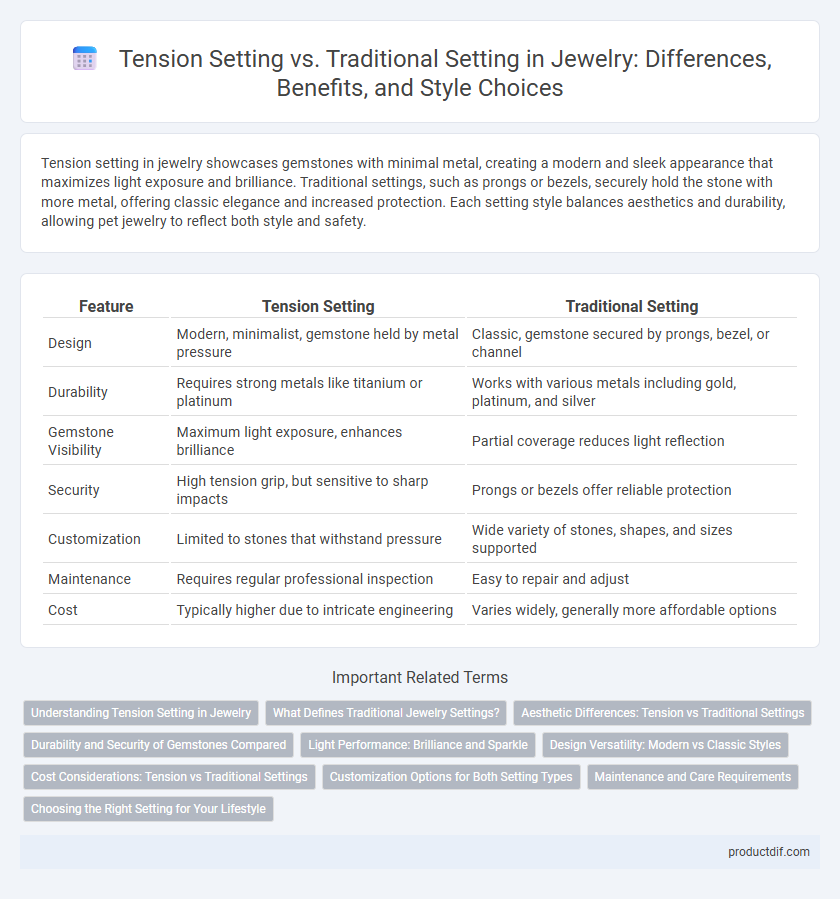Tension setting in jewelry showcases gemstones with minimal metal, creating a modern and sleek appearance that maximizes light exposure and brilliance. Traditional settings, such as prongs or bezels, securely hold the stone with more metal, offering classic elegance and increased protection. Each setting style balances aesthetics and durability, allowing pet jewelry to reflect both style and safety.
Table of Comparison
| Feature | Tension Setting | Traditional Setting |
|---|---|---|
| Design | Modern, minimalist, gemstone held by metal pressure | Classic, gemstone secured by prongs, bezel, or channel |
| Durability | Requires strong metals like titanium or platinum | Works with various metals including gold, platinum, and silver |
| Gemstone Visibility | Maximum light exposure, enhances brilliance | Partial coverage reduces light reflection |
| Security | High tension grip, but sensitive to sharp impacts | Prongs or bezels offer reliable protection |
| Customization | Limited to stones that withstand pressure | Wide variety of stones, shapes, and sizes supported |
| Maintenance | Requires regular professional inspection | Easy to repair and adjust |
| Cost | Typically higher due to intricate engineering | Varies widely, generally more affordable options |
Understanding Tension Setting in Jewelry
Tension setting in jewelry uses pressure to securely hold the gemstone in place, creating a floating appearance that maximizes light exposure and brilliance. This technique differs from traditional prong or bezel settings, which rely on metal claws or rims to encase the stone. Understanding tension settings helps buyers appreciate the innovative craftsmanship that offers a modern, sleek aesthetic combined with durability.
What Defines Traditional Jewelry Settings?
Traditional jewelry settings are defined by securely holding gemstones using prongs, bezels, or channels made from precious metals like gold, platinum, or silver. These settings emphasize craftsmanship and protection, ensuring durability while allowing maximum light exposure to enhance the stone's brilliance. Classic styles such as prong, bezel, and pave settings offer timeless elegance and structural reliability.
Aesthetic Differences: Tension vs Traditional Settings
Tension settings create a modern, minimalist look by suspending the gemstone between two metal bands, maximizing light exposure and enhancing brilliance. Traditional settings, such as prong or bezel, offer a classic, secure frame that often adds intricate detailing and metalwork around the stone. The open design of tension settings emphasizes the gem's size and sparkle, while traditional settings provide a more structured and timeless aesthetic.
Durability and Security of Gemstones Compared
Tension settings hold gemstones securely in place using compressive force, offering high durability by minimizing metal contact and reducing wear over time. Traditional settings, such as prong or bezel, rely on metal claws or encasements that can loosen or bend, potentially compromising gemstone security. While tension settings provide a modern, sleek look with robust grip, traditional settings may offer enhanced protection for softer gems through surrounding metal reinforcement.
Light Performance: Brilliance and Sparkle
Tension settings enhance light performance by maximizing the diamond's exposure to light, allowing more brilliance and sparkle compared to traditional prong or bezel settings. The minimal metal interference in tension settings ensures light enters the diamond from multiple angles, creating exceptional fire and scintillation. Traditional settings often limit light reflection due to metal coverings, reducing the overall brightness and visual impact of the gemstone.
Design Versatility: Modern vs Classic Styles
Tension settings offer a sleek, modern design ideal for contemporary jewelry, showcasing gemstones with minimal metal interference and emphasizing clean lines. Traditional settings provide classic styles that highlight intricate detailing and varied prong or bezel designs, catering to timeless elegance. Both settings enhance design versatility by accommodating different aesthetic preferences, from bold modern looks to refined vintage-inspired pieces.
Cost Considerations: Tension vs Traditional Settings
Tension settings often require precision engineering and durable metals, making their costs generally higher than traditional settings. Traditional settings, utilizing prongs or bezels, tend to be more affordable due to simpler craftsmanship and widely available materials. Customization and the complexity of design significantly influence the final price in both tension and traditional jewelry settings.
Customization Options for Both Setting Types
Tension settings offer a modern, sleek aesthetic with the ability to customize the stone size and shape prominently, creating a floating effect that showcases the gem uniquely. Traditional settings provide extensive customization through various prong or bezel designs, metal types, and intricate detailing, allowing for classic or ornate styles. Both setting types accommodate personalization but cater to different preferences, with tension focusing on minimalism and traditional settings emphasizing heritage craftsmanship.
Maintenance and Care Requirements
Tension setting jewelry requires careful maintenance to ensure the metal retains its strength and securely holds the gemstone, often needing regular inspections for tightness and potential stone movement. Traditional settings, such as prong or bezel, may require more frequent cleaning to remove debris from crevices but are generally easier to repair if stones become loose. Both settings benefit from routine professional evaluations, but tension settings demand more precise care to prevent damage caused by impacts or metal fatigue.
Choosing the Right Setting for Your Lifestyle
Tension settings offer a modern, sleek design that securely holds gemstones with pressure, ideal for active lifestyles due to their durability and minimal maintenance. Traditional settings, such as prong or bezel, provide classic looks with enhanced protection for softer stones and are better suited for those seeking timeless elegance. Choosing the right setting depends on balancing aesthetic preferences with daily activities and gemstone type to ensure long-lasting beauty and security.
Tension setting vs traditional setting Infographic

 productdif.com
productdif.com